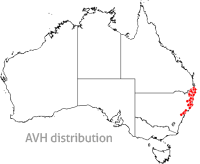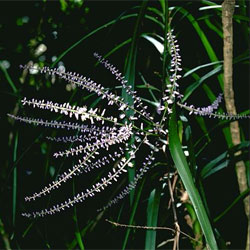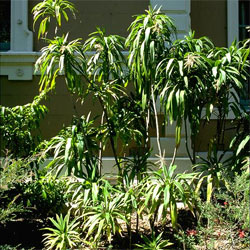Cordyline stricta
Slender Palm Lily, Narrow-leaved Palm Lily
Cordyline stricta (Sims) Endl.
 Cordyline stricta is commonly known as the Slender Palm Lily or Narrow-leaved Palm Lily. It is currently placed in the family Asparagaceae, though other family affiliations can be found in older references. These other families are Liliaceae, Asteliaceae, Lomandraceae, Laxmanniaceae, Draceaenaceae and Agavaceae.
Cordyline stricta is commonly known as the Slender Palm Lily or Narrow-leaved Palm Lily. It is currently placed in the family Asparagaceae, though other family affiliations can be found in older references. These other families are Liliaceae, Asteliaceae, Lomandraceae, Laxmanniaceae, Draceaenaceae and Agavaceae.
Its native range forms a band from the southern border of Queensland to the Sydney region, but it has become naturalised in Victoria and possibly South Australia. It grows in rainforests and wet sclerophyll forests, with dark, moist gullies being the preferred habitats.
Cordyline stricta has narrow, strappy leaves 30-50cm long and 1-2.5cm wide, which tend to be crowded near the top of the stem and leaving scars. There is no distinction between a leaf blade and petiole. When grown in the garden it can reach about 5m high, with highly branched stems that can sprawl or arch. It remains around 2-3m tall when grown in pots, and has a sparser, more compact growth habit.
Cordyline stricta is already a popular ornamental plant. It can grow in sun or shade, and in shallow or deep soils. Though it thrives in moist conditions, it is very drought tolerant; so an established plant should require little supplemental watering. It is frost-tender, so in cold climates it should be placed under cover or near a northeast-facing wall. If it is damaged by frost or desiccation, it can resprout when conditions are better. Its tolerance of low light and water also make it an attractive and low-maintenance potplant for indoors or outdoors.
Cordyline stricta usually flowers in summer, though it can reportedly flower earlier in the year. It produces 8-10mm pale purple flowers on panicles 20-40 cm long. The flowers are followed by 10-15mm black berries. It is the only Australian species of Cordyline to have black berries, so they are a useful diagnostic feature.
Cordyline stricta is easily propagated by seeds or cuttings, and it can easily reproduce itself by self-sowing or layering if the conditions are sufficiently moist. This does mean that it has some potential to take over gardens, so it may need to be controlled if it gets out of hand. It is not recommended for growing in places where it may invade bushland outside its native range. C. stricta does not appear to be susceptible to damage by pests or diseases, but it is a food plant for the Miskin's swift butterfly.
Text by Richard Boyne (2012 Student Botanical intern)
Name Meaning: Cordyline strictaCordyline — from the Greek cordyle, meaning club or swelling, a reference to the stem shape of some species. stricta — Latin for straight or rigid, referring to this species' long, upright stems. |
References
Anon. (2007) Cordyline stricta. Australian Native Plants Society (Australia) Available at http://anpsa.org.au/c-str.html [Accessed 14th February 2012].
Carolin, R. & Tindale, M. (1993) Flora of the Sydney Region. 4th ed. Reed, Chatswood.
de Lange, P. J., Sawyer, J. W. D. & Rolfe, J. R. (2006) New Zealand Indigenous Vascular Plant Checklist. New Zealand Plant Conservation Network, Wellington. Available at http://www.nzpcn.org.nz/publications/NZ%20Vascular%20Plant%20list%202006.pdf [Accessed 15th February 2012].
Elliot, W. R. & Jones, D. L. (1984) Encyclopaedia of Australian Plants Suitable for Cultivation. Volume 3. Lothian Publishers Ltd., Melbourne, Sydney.
Fagg, M. & Wrigley, J. W. (2003) Australian Native Plants. 5th ed. Reed New Holland, Sydney.
Fairley, A. & Moore, P. (2010) Native Plants of the Sydney Region. 3rd ed. Allen & Unwin, Crows Nest.
Golson, T. & Uwedo-Hampshire, R. (2012 ) (Pers. comm..) Horticulturalists, Australian National Botanic Gardens.
Harden, G. J. (2012) Cordyline stricta (Sims) Endl. PlantNET - The Plant Information Network System of The Royal Botanic Gardens and Domain Trust, Sydney, Australia (version 2.0). Available at http://plantnet.rbgsyd.nsw.gov.au/cgi-bin/NSWfl.pl?page=nswfl&lvl=sp&name=Cordyline~stricta [Accessed 14th February 2012].
Harden, G. J. (ed) (1991) Flora of New South Wales. Vol 4. New South Wales University Press, Sydney.
Herbison-Evans, D. & Crossley, S. (2009) Sabera dobboe (Plotz, 1885). Coffs Harbour Butterfly House. Available at http://lepidoptera.butterflyhouse.com.au/hesp/dobboe.html [Accessed 16th February 2012].
Ho, B-m. (2006) Cordyline obtecta. Growing Native Plants. ANBG. Available at http://www.anbg.gov.au/gnp/interns-2006/cordyline-obtecta.html [Accessed 15th February 2012].
Pedley, L. & Forster, P. I. (1986) Agavaceae, Flora of Australia. Volume 46. Australian Government Publishing Service, Canberra.
![An Australian Government Initiative [logo]](/images/austgovt_brown_90px.gif)



